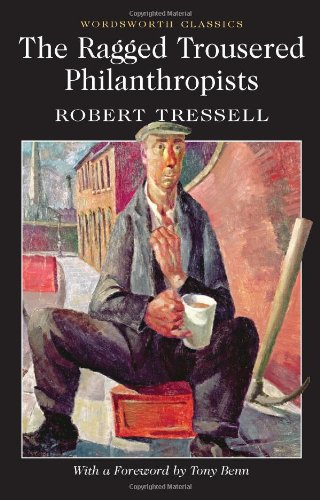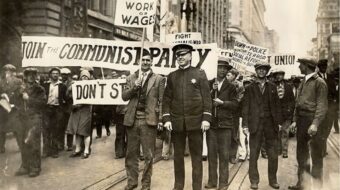
The 20th century Marxist philosopher Louis Althusser argued that bourgeois art operated on the model of consumption: the play, novel or painting was meant to arouse and satisfy our desires, leaving us content and complacent. By contrast, radical art, he suggested, must instead aim to “produce a new, true and active consciousness” in its audience. What we need, Althusser suggested, is art that both helps us to recognize the social structures that shape our lives and also motivates us to go out and transform them.
In an era when most works of art are meant to leave us satisfied, glutted with special effects and violence and fantasy and sex, motivated only to buy the DVD or look forward to the sequel, such radical art seems hard to come by. So perhaps it is time to recall a great work of socialist literature from the past: The Ragged-Trousered Philanthropists, by Robert Tressell, published 100 years ago this year.
Tressell was the pen name of Robert Noonan, a British house painter and socialist who was born in Ireland in 1870 and died in England of tuberculosis in 1911 at the age of 41. The novel was published, with the help of his daughter, three years after his death, and has remained popular in England ever since, sometimes credited with helping promote the Labour Party in the United Kingdom.
Writing in the early part of the 20th century, Tressell describes the gradual decline in prosperity of the working class following the 1907 depression, a decline that seemed to have no end in sight, with each passing year seeing more men out of work, more families becoming homeless, and an increasingly difficult struggle to survive on sporadic work and multiple low-paying jobs. Tressell’s novel is set in a time before computers and cell phones, when the automobile was new and uncommon. But the economic hardship faced by the working class following a financial crisis from which the rich “recovered” while workers were forced to accept lower wages and a diminished standard of living … well, that sounds all too familiar, right?
Tressell seems to have written the novel in an attempt to solve the great problem that has always faced socialists: how do we overcome the power of capitalist ideology? Throughout the book, we hear Tressell’s frustration, often given voice by the character Frank Owen, a socialist house painter who repeatedly attempts to convert his coworkers to his way of thinking. Late in the book, during a parliamentary election campaign, Owen once again faces despair: “They did not know the causes of their poverty, they did not want to know, they did not want to hear.” The majority of the working men support the conservative Tory party, sure that this party will give them “plenty of work” by means of some rather obscure financial and tax reforms.
Despite his obvious frustration, Tressell rejects the cynical path taken by one socialist in the novel, who gets tired of being abused by those he is trying to help and turns to writing campaign speeches for the Tory party. For Tressell, the only hope for our children, for the future of the majority of the human race, is to keep working to produce a socialist party. This novel is one part of such work, and it attempts to combine two different approaches to achieve this end.
One part of the novel is a traditional melodrama reminiscent of many Victorian novels. We witness men out of work struggling to make the rent, buy food, and clothe their children; older workers sent to the workhouse and early death; and the wives of these working men putting in 14-hour days doing piecework sewing at home or cleaning houses, until several characters contemplate suicide as the only escape. The focus, in this part of the narrative, on the despair of the women and children is clearly meant to be motivational. The workers “do not want to know,” and Tressell hopes, by showing them the awful effects of this lingering economic recession, to make them feel the need to know.
The other part of the novel, probably the bulk of the writing, consists of social and economic satire, meant to expose corruption and to explain the inherent injustice in “The System.” Tressell tries, in multiple chapters, to find ways to explain the inherent contradictions of capitalism and the solutions offered by socialism, reminding us again and again that it isn’t a matter of a few corrupt and greedy individuals, that the capitalist system itself requires poverty and inequality. And his explanations are very well done, lucid and compelling.
Of course, as he also repeatedly reminds us, no matter how clearly explained, most people will just not want to understand, or if they do, will remain convinced that there’s nothing they can do to change things. This is where socialist art comes in, however. A novel like this should leave us frustrated and exasperated, motivated to work together to educate and agitate, to produce a socialist party. Our children’s lives depend on it.
Tressell didn’t live to see his novel published, but it has remained in print continuously for a century now, first in an abridged edition, then after 1955 in an edition that restored the novel, as closely as possible, to its original manuscript form. Today, it is available in a relatively cheap edition from Wordsworth Classics, as well as in free or very inexpensive digital formats.
Tressell’s depiction of the real daily life of ordinary working men and women is engaging and will likely ring true to anyone who has worked in such trades even today. And certainly all socialists can share his experience of frustration at the difficulty of the work to be done, the very hard work of helping people break through their illusions and misconceptions. His novel can serve as an inspiration to us, both to follow the example of his characters and work for a socialist future, and, hopefully, to write more such novels today, depicting the reality of working life with no fantasy Hollywood endings. The only solution is collective political effort, Tressell tells us. Part of that effort, he shows by example, is the creation of socialist art. Can we listen to him today?










